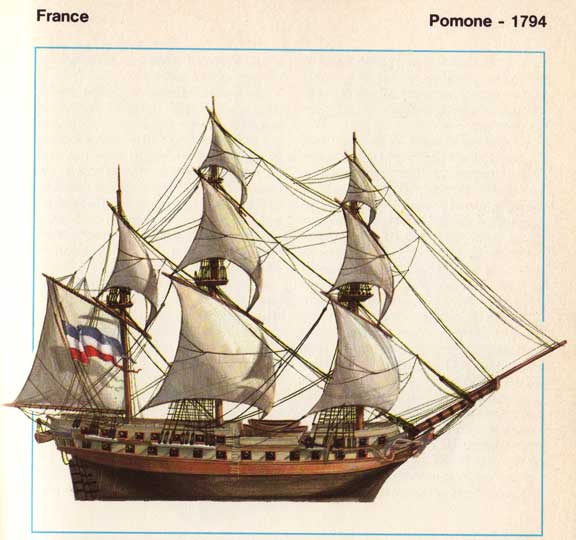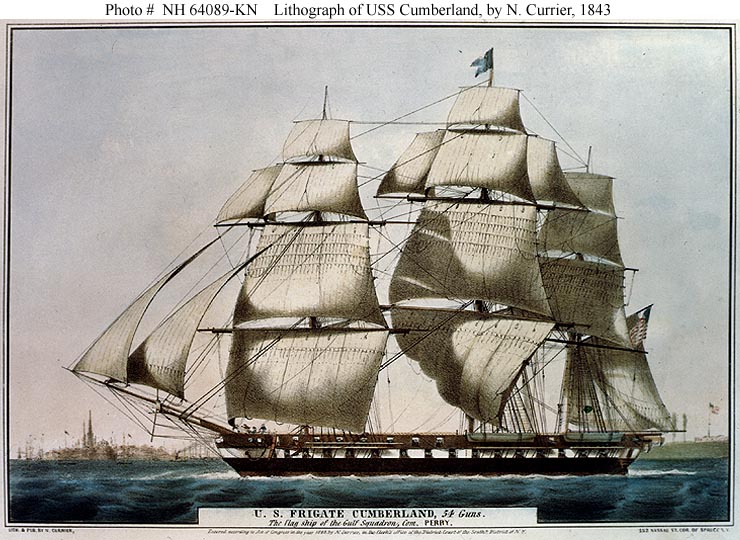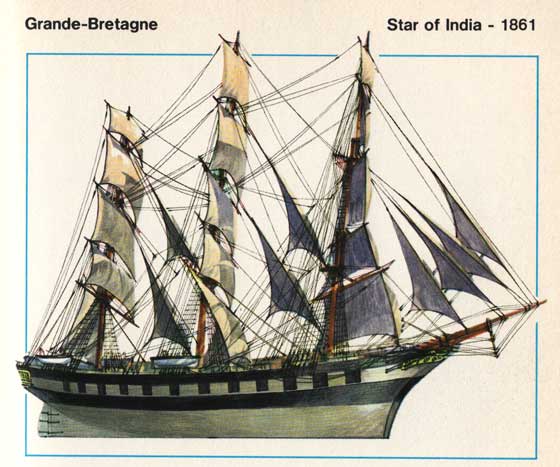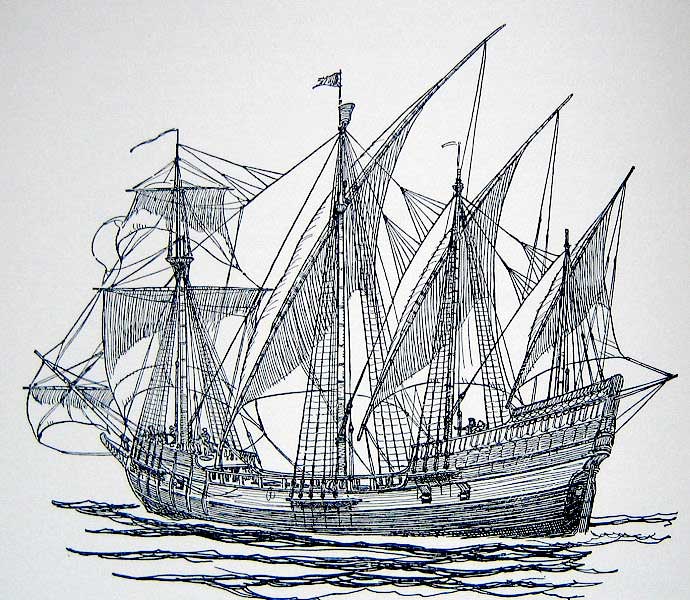
|
History of Ships Ships of Discovery Jean Vaucher (April 2019) |
- Prehistoric Craft
- Southeast Asia
- Viking Ships
- Age of Discovery (1400 - ...)

- Transportation: 1800-1900
In this section we consider ships developed for long distance exploration and trade - away from the Mediterranean.
Before the Age of Sail
In Europe, for a long time, boats were small, had one mast and seldom left sight of land. Ships like the Mediterranean galleys and the nordic drakkar relied mainly on oars for propulsion aided by square sails when there was a following wind. They would be steered with a "side oar" that would hang off the back of the boat.
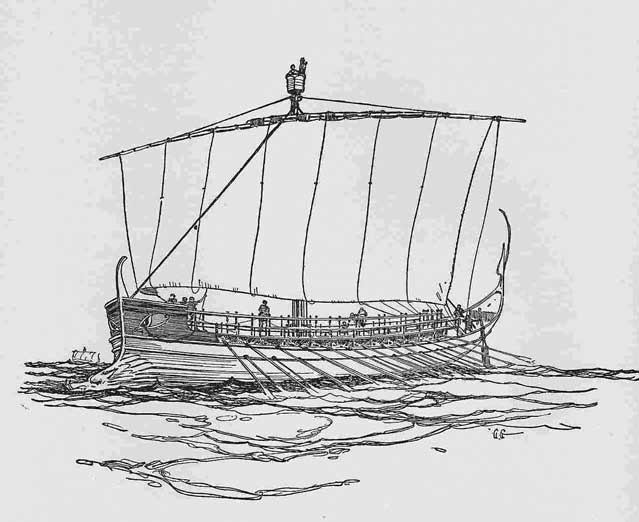
Venetian Galley |
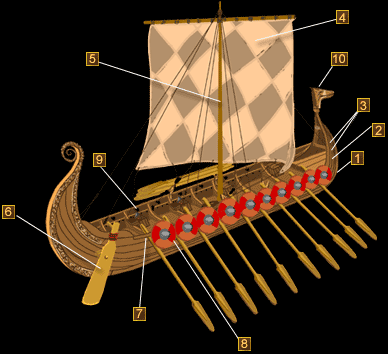
Viking Drakkar |
Renaissance Ships
In the 1300s, larger loads for war and commerce were handled by Cogs . In the north, the rudder had replaced the side oar for steering. In the Mediterranean, lateen sails working as windfoils allowed sailing upwind. Building techniques improved to allow the construction of larger crafts with multiple masts.
COG typical dimensions: |

Cog on Paris Crest
|
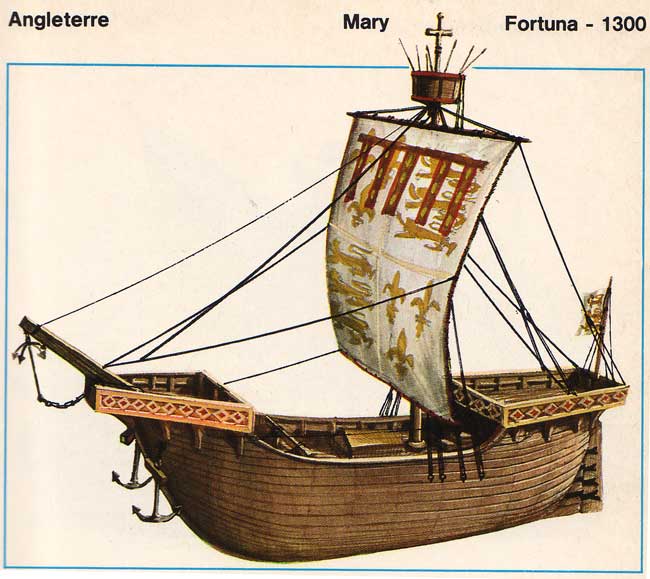
Northern Cog |
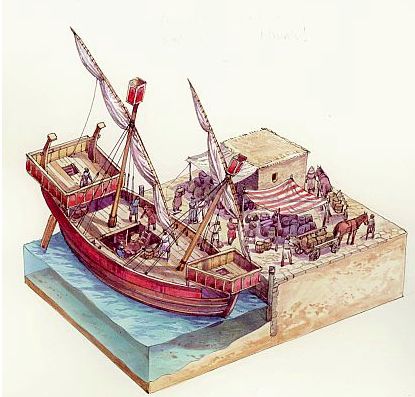
Mediterranean Cog |
Size measurements
Reported ship sizes in tons are confusing because there are 3 variants- Tonnage: volume of cargo space
- Old: volume in "tuns" or wine barrels ( 1 m3 or 40 cu. ft. )
- Register Tons: volume in 100 cu.ft. units
- Deadweight Tons (Port en lourd): Maximum cargo weight
The age of discovery (1400-1550)
Two types of ships were developped:
- small ships for exploration: caravels
- a shallow draft to chart unknown waters
- ability to sail to windward (lateen sails)
- small crew
- cargo space for voyages of up to a year
- larger ships for war and commerce: carracks
- high platforms at front and back from which to fire at opponents
- armed with cannons
- square sails for more sail area
- large payload
Caravel
The design of caravels underwent changes over the years, but a typical caravel of the late 15th century may be described as a broad-beamed vessel of 50 or 60 tons burden; some were as large as 160 tons. About 75 feet (23 m) long, the typical caravel had two or three pole masts, lateen-rigged (i.e., with triangular sails). Later versions, the redonda, replaced the main lateen sail which required a large crew by a square sail which also made for more speed when running offshore. Caravels were usually built with a double tower at the stern (the aftercastle, or sterncastle) and a single tower (or none) in the bow (the forecastle). Top speed for a caravel was about 8 knots; the average was 4 knots for 90-100 miles in a day.

Caravela latina |
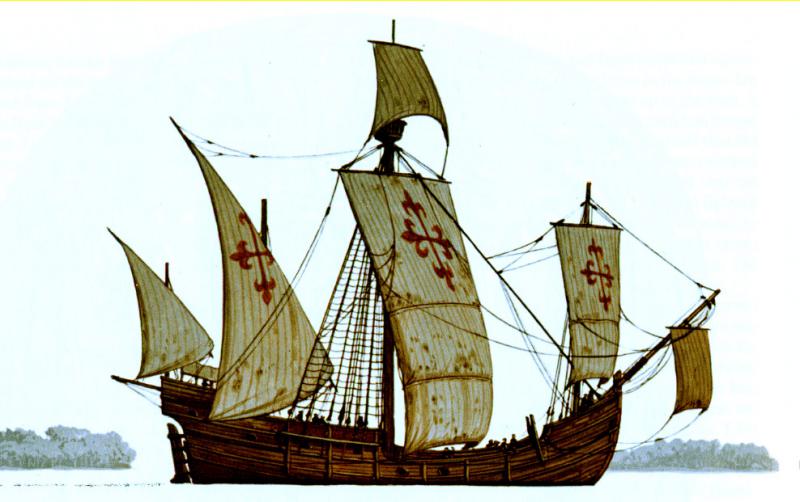
Caravela redonda |

|

Large Caravel |
In 1492 Colombus's used 2 caravels, the Nina and the Pinta, and a larger carrack, the Santa Maria, as his flagship [More].
Carrack
The carrack (called nao, for ship, by the Portuguese) was the beast of burden of the 16th century, carrying cargo and troops to faraway lands. It rode high in the water with the prominent forecastle (along with the usual sterncastle) giving it a characteristic "U" shape. The high sides made it virtually impregnable to attack from small craft, which was often a problem in the East Indies. The forecastle located directly above the stem, with the bowsprit rising from its top made sailing to windward difficult and would disappear in gallions which come next. The square rigging with a lateen mizzen is typical of the age but we see a second row of top sails needed to drive this heavy ship.Large carracks had ample room for large crews, provisions and cargo required for east Indies trading. Their size and stability allowed mounting of cannons.

Typical Carrack |
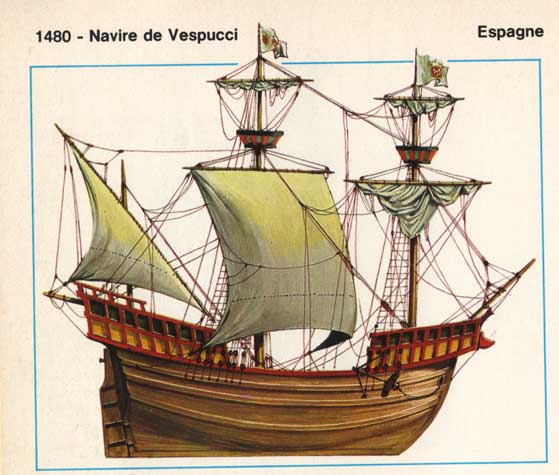
Vespucci's ship 468 tons, 86 men |
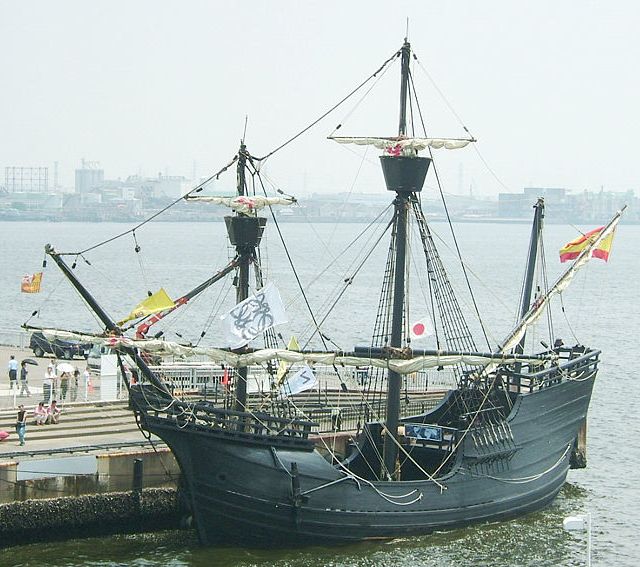
Magellan's Victoria Replica |

Carrack |
Carracks were also used by Vasco de Gama for the first successful trip to India around the Cape of Good Hope. In 1498, de Gama left Portugal with 170 men, 3 carracks and one caravel; he returned 22 months later with only 2 ships and 55 men. He had sailed 24,000 miles and spent 300 days at sea [ BBC History ]. For the next 100 years, the Portuguese controled the East India trade, sending a fleet to India almost every year, scheduled to coincide with the monsoons. For more details see our historical page.
Carracks for exploration like the Santa Maria or de Gama's San Gabriel were small, about 90 tons; but merchant ships would average 250-500 tons with a crew of 40-80 and some war ships went up to 1000 tons. The average speed was about 80 miles/day and the trip to India took 6 to 8 months each way.
Wreck of a merchant Nao
Exploration of a sunken Nao, the Nossa Senhora dos Mártires has provided much information about these ships."In 1606, after 9 month at sea returning from India, the Nossa sank in view of Lisbon. She was a Nao with a 40 m hull and 9 m beam. The cargo, the main reason for the voyage, consisted of 250 tons of peppercorns, complemented with many other spices and drugs, countless bales of cotton and silk cloth of all sizes and colors, furniture, porcelain, exotic animals and thousand of luxury items from the workshops of the far east. The ship also carried 450 people, including crew and passengers, food and water for six months, spares and fittings." [see Pepper Wreck]
Inside of a ship
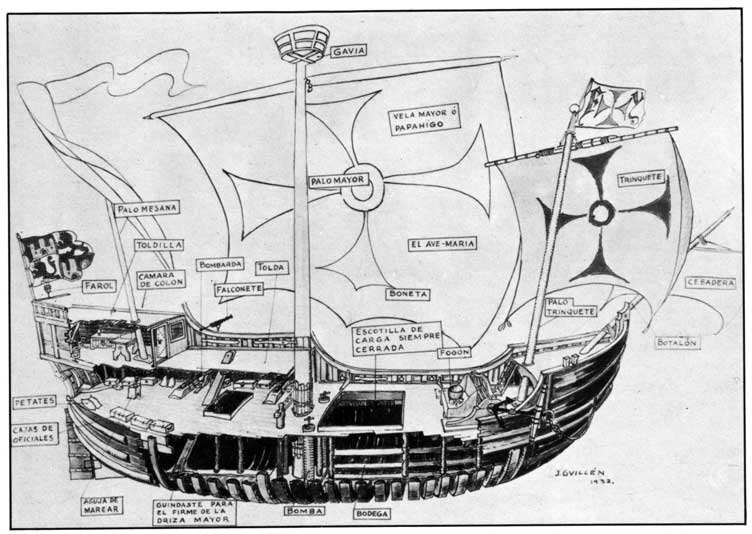
Columbus ship Single hold |
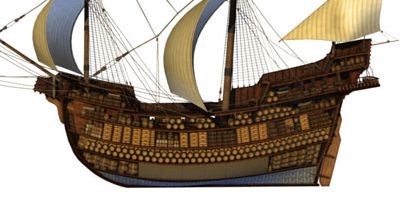
A 600 ton India Nao (4 decks below) |
| Click images to enlarge | |
Texas A&M References:
- The Pepper Wreck Project, J.R. Steffy, Ship Lab, Center for Maritime Archeology
- Virtual Model of a Nau, A. Wells, Texas A&M
- Virtual Reconstruction of a Nao, A. Wells Master's thesis (5Mb PDF file)
- History of Wreck Site (+ ShipLab links )
Galleons
The Galleon differed from older designs primarily by being longer, lower and narrower, with a square tuck stern instead of a round tuck, and by having a snout or head projecting forward from the bows below the level of the forecastle [Note: the head housed the crew's toilets]. The forecastle was also made smaller and moved back. These changes, pioneered by the English under Elizabeth, made their galleons faster and more manoeuvrable and enabled them to sail considerably closer to the wind.Note: modern sailboats with fore and aft rigs can sail about 40° to the wind but at best a square rig could only do 70°.
Galleons also started using portholes to allow guns to be mounted lower in the hull and not just on deck. This made it possible to have more powerful guns which would not capsize the ship when fired. The Galleon was a sound multi-purpose design. War ships would have cannons on all decks whereas a merchant might have one gun deck and use the others for cargo.
Whereas, carracks were usually very large ships (often over 1000 tons), galleons were mostly under 500 tons. The Manila galleons, were to reach up to 2000 tons, were the exception. From 1565 to 1815, these were Spanish trading ships that sailed once or twice per year across the Pacific Ocean between the Philippines and Acapulco in New Spain. Goods would then be taken overland to VeraCruz and hence to Spain.
The galleon continued to be used until the early 18th century, when better designed and purpose-built vessels such as the fluyt, brig and the ship of the line rendered it obsolete for trade and warfare respectively. In time, the long beak became curved and shorter, top sails were added, jibs were introduced and the lateen-rigged mizzenmast was replaced with a gaff rigged spanker sail.

Spanish Galleon |

Adler von Lübeck (1565) Hanseatic League warship 2500 tons, 138 cannons |

Drake's Golden Hind (1580) |
Parts of a Galleon

| a) Bowsprit Sail | b) Waterline | c) Bowsprit | d) Anchor | e) Rudder | f) Mizzen Mast | g) Mizzen Sail |
| h) Main Mast | i) Crowsnest | j) Top Sail | k) Main Sail | l) Foresail | m) Foremast | n) Bowsprit Mast |
East Indiamen
These were built by the various East India companies (Dutch, English or scandinavian) to bring back tea, china, silk and spices. Over the years, the high castles disappeared in favour of a lower beamier shape. In capacity they ranged from 600-1500 tons but the speed remained around 4-5 knots for an average of 120 miles/day.
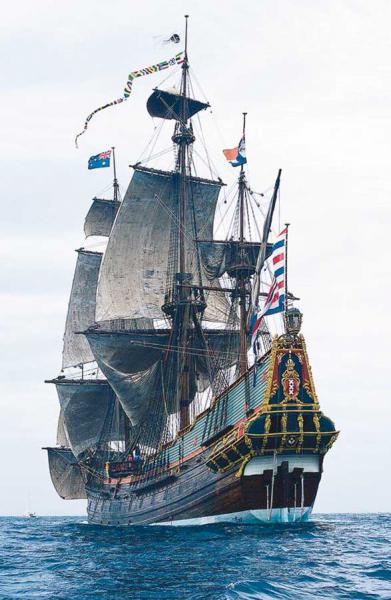
Batavia (1628) |
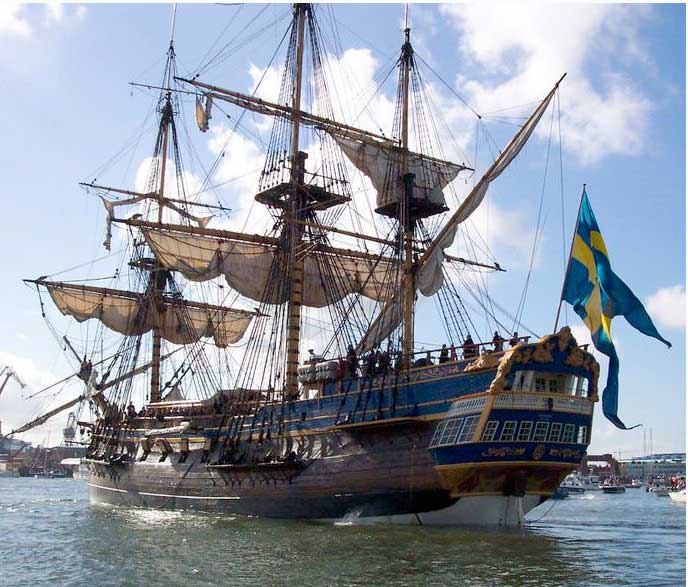
Gotheborg (1740) |

Amsterdam (1750) |
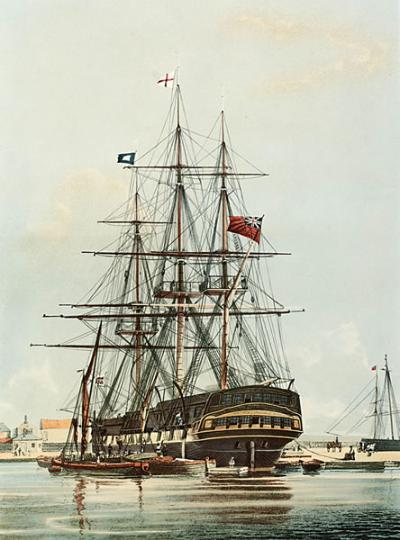
Arniston (1794) |
The route to Java & China
 The book China and Denmark (2001) gives a detailed description of a typical journey to China in 1742 by the Danish Indiaman, Dronningen af Danmark. The Dronningen, similar to the Bativia shown at left, was a 540 ton vessel with a crew of 150 including 10 traders and clerks. On the outward trip, the cargo, in terms of value, was 90% silver, 5% cloth and 5% lead ingots. The return cargo was tea and porcelain.
The book China and Denmark (2001) gives a detailed description of a typical journey to China in 1742 by the Danish Indiaman, Dronningen af Danmark. The Dronningen, similar to the Bativia shown at left, was a 540 ton vessel with a crew of 150 including 10 traders and clerks. On the outward trip, the cargo, in terms of value, was 90% silver, 5% cloth and 5% lead ingots. The return cargo was tea and porcelain.
In order to catch favorable monsoon winds, ships had to leave Copenhagen in December-January and it might take up to 3 months to get out of the North Sea into the Atlantic. Thereafter, the ships took the usual sailing to the Cape. Then China vessels would go straight east pushed by the Trade winds before turning north to aim for Sunda Strait between Java and Sumatra and on to Canton. The return journey would again pass by the Sunda Strait before aiming directly for the Cape. The passage from Copenhagen to Canton normally took 7-8 months at sea followed by 4-5 months in Canton obtaining cargo, repairing and refitting the ship. The return trip was faster: 6 months for a total round trip of 18-20 months.
This route was used safely by Europeans for over 100 years. In the 40 years from 1732 to 1772, 65 ships made the journey and only 6 were wrecked (4 on the North Sea leg). However, wear and tear was such that the useful life of a ship was 4-5 voyages (8-10 years).
The 650 ton Batavia, shown above, is better known for the fact that its skipper planned to hijack the ship on its maiden voyage in 1628. He steered away from the rest of the fleet but went too far and struck a reef off the west coast of Australia.
Further Evolution of Ships
War ships evolved from galleons into 100 gun Ships of the Line like Nelson's Victory (below) and the Napoleonic wars brought further refinement of square rig sailing configurations. These massive flagships were complemented by smaller faster craft with fewer guns like frigates which would serve as models for the clippers to come.
Into the 19th c.: Clippers
In Europe, the Napoleonic wars brought further refinement of square rig sailing configurations. In North America, The Americans designed the clipper as a response to the British naval blockade in the war of 1812. The clipper was developed for speed, often capable of reaching 20 knots, in contrast to the 5-6 knots attained by other cargo ships of the day. It would serve for commerce of Tea (and opium).
- Source: Era of Clippers
Next: Transportation (1800-1900)
Sources:
- Pirate Site
- Renaissance ships
- Intaglio Naval Prints
- Colin Munro, Sailing Ships, Pelham, 1973. Excellent outline drawings
- A. Cucari, Les grands voiliers du moyen âge à nos jours, Elsevier, 1978.



